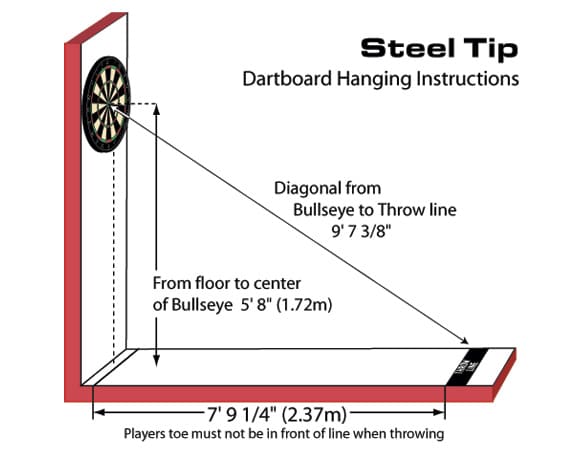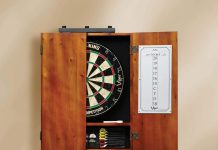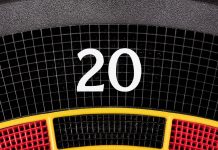Looking to set up your own dartboard at home but not sure about the dimensions? Look no further. In this article, we will explore the dimensions of a standard dartboard. Whether you’re a seasoned player or a casual enthusiast, understanding these measurements is essential for enjoying the game to its fullest. So, grab your darts and let’s get started on the journey to the perfect dartboard setup.
Review contents
Standard Dartboard Dimensions
Dartboard is a popular game that is enjoyed by both casual players and professionals alike. To ensure fair and consistent play, there are standard dimensions that dartboards must adhere to. In this article, we will explore the various dimensions of a standard dartboard, including the overall diameter, playing surface diameter, bullseye diameter, distance from the floor to the bullseye, height from the floor to the dartboard, distance from the front of the dartboard to the throwing line, throwing line height, standard dartboard thickness, numbering and layout, as well as the materials used.
This image is property of nwscdn.com.
Overall Diameter
The overall diameter of a standard dartboard is an important factor in determining the size of the playing area. Regulation dartboards have a diameter of 18 inches, which is the measurement from one edge of the board to the opposite edge. This size ensures that players have enough space to aim for their desired targets without the risk of hitting neighboring darts.
Playing Surface Diameter
The playing surface diameter is the area on the dartboard where players target their throws. In regulation dartboards, the playing surface has a diameter of 13.25 inches. This measurement excludes the outer edge of the board, focusing on the scoring area where players aim for the highest points.
Bullseye Diameter
The bullseye, which is the center of the dartboard, has its own diameter. The standard dartboard includes two bullseye areas – the inner bullseye and the outer bullseye. The inner bullseye, also known as the double bullseye, has a diameter of 12.7 mm (0.5 inches). The outer bullseye, known as the single bullseye, has a diameter of 31.8 mm (1.25 inches). These smaller target areas provide additional challenge and higher point values for skilled players.
Distance from Floor to Bullseye
To ensure consistency in dartboard setup, there is a regulation height for the distance between the floor and the bullseye. The standard height for the bullseye is 5 feet 8 inches, or 1.73 meters, from the floor. This ensures that players of different heights can have an equal playing field and can throw their darts comfortably.
This image is property of global-uploads.webflow.com.
Height from Floor to Dartboard
The height from the floor to the dartboard is another essential dimension to consider. The regulation height for the dartboard is 5 feet 8 inches, or 1.73 meters, from the floor. This height allows players to stand at the throwing line and have a clear view of the dartboard, without straining or adjusting their posture.
Distance from Front of Dartboard to Throwing Line
The distance from the front of the dartboard to the throwing line is an important factor in determining the length of the throw. In regulation dartboards, the standard distance from the front of the dartboard to the throwing line, also known as the oche, is 7 feet 9.25 inches, or 2.37 meters. This distance provides players with a suitable throwing distance, allowing them to show off their accuracy and skill.
This image is property of cdn.shopify.com.
Throwing Line Height
Similar to other dimensions, the throwing line height is also regulated to ensure fair play. The regulation height for the throwing line is 1.5 inches, or 3.81 cm, from the ground. However, there is an allowable height range that allows for some flexibility. Players can adjust the throwing line height within this range to suit their preferences and playing style.
Standard Dartboard Thickness
The thickness of a standard dartboard is an essential factor that affects durability and gameplay. Regulation dartboards have a standard thickness of 1.5 inches, or 3.81 cm. This thickness ensures that the dartboard is sturdy and can withstand repeated throws, while also providing enough depth for the darts to stick securely into the board.
This image is property of www.dartworld.com.
Numbering and Layout
The numbering and layout of a standard dartboard follow a specific pattern. The numbers are arranged in a clockwise sequence, starting with 20 at the top and ending with 1 at the bottom. The inner bullseye is in the center, surrounded by the outer bullseye or single bullseye. The layout and numbering of the dartboard have remained consistent over the years, enabling players to develop strategies and target specific areas for high scores.
Material
Dartboards can be made from different materials, each with its own advantages and disadvantages. Traditional dartboards are made from sisal fibers compressed together, which provides excellent durability and allows for easy dart removal. Modern dartboards, on the other hand, are made from electronic materials and are typically used in electronic dartboards, which offer features like automatic scoring and interactive gameplay.
In conclusion, the dimensions of a standard dartboard are crucial in maintaining fair gameplay and ensuring consistency across all competitions and casual matches. From the overall diameter to the throwing line height, each dimension plays a vital role in creating an enjoyable and competitive environment for dart players. By adhering to these standard dimensions, players can hone their skills and compete on a level playing field, making every game of darts a thrilling experience.
This image is property of images.thdstatic.com.




























![Best Outdoor Dartboards [Reviews and Buying Guide 2024] Best Outdoor Dartboards](https://gamersets.com/wp-content/uploads/2022/12/Best-Outdoor-Dartboards-100x70.jpg)

![Best Mini Air Hockey Table [Reviews & Buying Guide 2024] Best mini air hockey table](https://gamersets.com/wp-content/uploads/2022/10/Best-mini-air-hockey-table-100x70.jpg)







